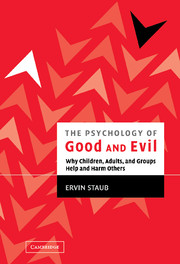Book contents
- Frontmatter
- Contents
- Preface
- Acknowledgments
- PART I INTRODUCTION AND CORE CONCEPTS
- PART II THE ROOTS OF HELPING OTHER PEOPLE IN NEED IN CONTRAST TO PASSIVITY
- PART III HOW CHILDREN BECOME CARING AND HELPFUL RATHER THAN HOSTILE AND AGGRESSIVE
- 10 The Origins of Caring, Helping, and Nonaggression: Parental Socialization, the Family System, and Cultural Influence
- 11 Natural Socialization: The Role of Experience or Learning by Doing
- 12 The Origins of Hostility and Aggression
- 13 Cultural–Societal Roots of Violence: Youth Violence
- 14 Bystanders and Bullying
- 15 Students' Experience of Bullying and Other Aspects of Their Lives in Middle School in Belchertown: Report Summary
- 16 Passive and Active Bystandership across Grades in Response to Students Bullying Other Students
- 17 Self-Esteem and Aggression
- 18 Father–Daughter Incest
- 19 Reducing Boys' Aggression: Learning to Fulfill Basic Needs Constructively
- 20 Creating Caring Schools: Design and Content of a Program to Develop Caring, Helping, Positive Self-Esteem, and Nonviolence
- PART IV THE ORIGINS OF GENOCIDE, MASS KILLING, AND OTHER COLLECTIVE VIOLENCE
- PART V THE AFTERMATH OF MASS VIOLENCE: TRAUMA, HEALING, PREVENTION, AND RECONCILIATION
- PART VI CREATING CARING, MORALLY INCLUSIVE, PEACEFUL SOCIETIES
- Appendix: What Are Your Values and Goals?
- Index
- References
13 - Cultural–Societal Roots of Violence: Youth Violence
Published online by Cambridge University Press: 07 May 2010
- Frontmatter
- Contents
- Preface
- Acknowledgments
- PART I INTRODUCTION AND CORE CONCEPTS
- PART II THE ROOTS OF HELPING OTHER PEOPLE IN NEED IN CONTRAST TO PASSIVITY
- PART III HOW CHILDREN BECOME CARING AND HELPFUL RATHER THAN HOSTILE AND AGGRESSIVE
- 10 The Origins of Caring, Helping, and Nonaggression: Parental Socialization, the Family System, and Cultural Influence
- 11 Natural Socialization: The Role of Experience or Learning by Doing
- 12 The Origins of Hostility and Aggression
- 13 Cultural–Societal Roots of Violence: Youth Violence
- 14 Bystanders and Bullying
- 15 Students' Experience of Bullying and Other Aspects of Their Lives in Middle School in Belchertown: Report Summary
- 16 Passive and Active Bystandership across Grades in Response to Students Bullying Other Students
- 17 Self-Esteem and Aggression
- 18 Father–Daughter Incest
- 19 Reducing Boys' Aggression: Learning to Fulfill Basic Needs Constructively
- 20 Creating Caring Schools: Design and Content of a Program to Develop Caring, Helping, Positive Self-Esteem, and Nonviolence
- PART IV THE ORIGINS OF GENOCIDE, MASS KILLING, AND OTHER COLLECTIVE VIOLENCE
- PART V THE AFTERMATH OF MASS VIOLENCE: TRAUMA, HEALING, PREVENTION, AND RECONCILIATION
- PART VI CREATING CARING, MORALLY INCLUSIVE, PEACEFUL SOCIETIES
- Appendix: What Are Your Values and Goals?
- Index
- References
Summary
cultural–societal sources of the socialization and experiences that lead to aggression
Difficult Life Conditions
To understand the increase in aggression by youth, we must specify not only cultural–societal influences, but also changes in those influences. In my view, there have been moderately difficult life conditions in the United States in the past quarter of a century, created primarily by tremendous cultural–societal change. Great, rapid social change, even of a positive kind, creates psychological dislocation and frustrates basic needs in people, which affects their treatment of children.
The following have been some of the elements of difficult life conditions in the United States. Starting in the 1960s, a number of important leaders were assassinated. The United States fought a major war that created a great schism within the country. The United States lost economic power and prestige. The civil rights movement and feminism brought major changes to social arrangements and individual lives. There have been changes in gender relations and sexual mores, an increase of women in the workforce, and great increases in divorce rates and in single parenting. The drug culture (both taking and selling drugs) has affected many people's lives. Some of these changes, and the loss of clear guiding values associated with them, have had direct effects on family life, parenting, and the experiences of children, effects that are the proximal causes of youth violence.
- Type
- Chapter
- Information
- The Psychology of Good and EvilWhy Children, Adults, and Groups Help and Harm Others, pp. 212 - 223Publisher: Cambridge University PressPrint publication year: 2003
References
- 1
- Cited by



